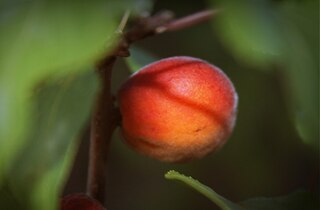
Prunus sibirica, commonly known as Siberian apricot, is a species of shrub or small tree native to northern China, Korea, Mongolia, and eastern Siberia. It is classified in the rose family, Rosaceae, and is one of several species whose fruit are called apricot, although this species is rarely cultivated for its fruit. The species was named by Carl Linnaeus in 1753.
Zanthoxylum macranthum , is a species of woody plants in the family Rutaceae. It is native to the upland open forests and thickets in south-east Tibet and southern China, and has been found in Chongqing (Nanchuan), Guizhou, south-west Henan, western Hubei, Hunan, Sichuan, southern Yunnan (Xishuangbanna), and south-east Xizang.
Zanthoxylum austrosinense, or South Chinese Sichuan pepper, is a woody plant in the family Rutaceae and is native to southern China.

Zanthoxylum avicennae is a woody plant in the family Rutaceae.
Zanthoxylum calcicola is a woody plant in the Rutaceae family. It is native to Yunnan, Guizhou, and Guangxi in China.
Zanthoxylum dissitum is a woody plant native to China. It grows in upland thickets and open forests, forests, at 300–2600 m altitude.
Zanthoxylum echinocarpum is a woody plant in the family Rutaceae and is native to South-Central and Southeast China.
Zanthoxylum glomeratum is a woody plant in the Rutaceae family, it is native to Southeast and South-Central China.
Zanthoxylum khasianum is woody plant in the family Rutaceae native to Attam and South Central China.
Zanthoxylum kwangsiense is a woody plant from the Rutaceae family, it is native to northwestern Guangxi, Guizhou (Libo), and Sichuan China.
Zanthoxylum laetum is a species of woody plant from the Rutaceae family.
Zanthoxylum leiboicum is a woody plant in the Rutaceae family and is native to Sichuan in China, and is known there as léi bō huā jiāo (雷波花椒).
Zanthoxylum liboense (Chinese: 荔波花椒 is a plant in the Rutaceae family.
Zanthoxylum micranthum is a woody plant in the family Rutaceae. It is native to Hubei, Hunan, Guizhou, Sichuan, and Yunnan provinces in China.
Zanthoxylum molle is a woody plant from the Rutaceae family.
Zanthoxylum multijugum is a woody climber from the family Rutaceae.
Zanthoxylum motuoense is a woody plant from the Rutaceae family and is native to Medog, Tibet.
Zanthoxylum pilosulum is a woody plant from the Rutaceae family native to western and northwestern Sichuan and southern Shaanxi and Gansu provinces, China.
Zanthoxylum undulatifolium is a woody plant from the Rutaceae family. It is native to western Hubei, eastern Sichuan, Taibai Mountain in southern Shaanxi to the Three Gorges of the Yangtze River in China.
Zanthoxylum yuanjiangensis is a woody plant in the Rutaceae. It is native to Yuanjiang, Yunnan, China.

